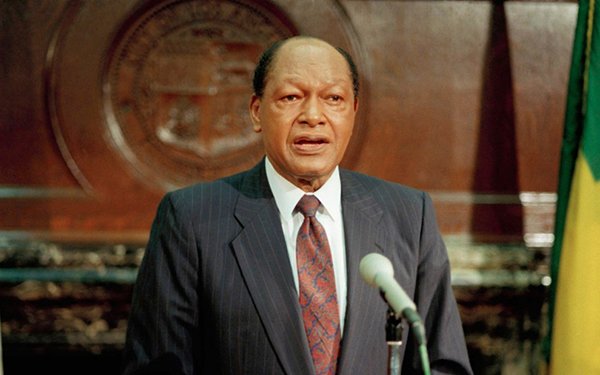From the Los Angeles Skyline to MTA Transit System, Bradley Made Visions Reality

The first Black mayor of Los Angeles, Tom Bradley is pivotal in the vibrant Los Angeles we see today due to his tireless work for 20 years, the longest mayoral term served in the history of the city. (AP Photo)
Los Angeles is the second largest city in the country and didn’t become the city it is on its own. You can thank the 38th and first Black mayor of Los Angeles, Tom Bradley. Beyond his role as mayor, he was also a Los Angeles police lieutenant for 21 years, attorney and a community leader who fought for equal rights amongst races, gender and sexual orientation and proper relations between police and the Black community. And with his leadership and steadfast work as mayor of California for 20 years, he has helped Los Angeles become the thriving city that it is today.
Bradley was born on December 29, 1917 and resided in Calvert, Texas with his parents who were poor sharecroppers. His grandfather was a former slave. When he was 7 years old, his family believed that Los Angeles held many opportunities for them, so they decided to move there and start a new life. He attended UCLA and was a devoted student and track star.
In 1963, Bradley was elected to the Los Angeles City Council in the 10th district. A coalition created in 1949 by City Councilman Edward Roybal, which hosted local church leaders and community leaders supported Bradley and were instrumental in continuously backing up his future campaigns. In 1973, Bradley won the election for Los Angeles mayor against the odds. He was running against the former mayor, Sam Yorty for the second time who previously used scare tactics and racial politics to sway the voters and community away from Bradley. It had been 8 years since the Watts Riots in South Central Los Angeles, which spread a lot of fear within communities. With a majority white population, Bradley was still able to win the election and become the mayor of Los Angeles, for what would begin the longest mayoral term in the history of the city.

Los Angeles Mayor Tom Bradley with his wife, Ethel, left, and daughter, Lorraine (AP Photo / Lennox McLendon)
“Tonight was a full filament of a dream, the impossible dream. Victory which has come tonight, is not just a victory for Tom Bradley, not just a victory for the campaign, but a victory for progress, a victory for our children,” Bradley stated in a speech he made on election day.
Perhaps one of the most overlooked successes of Bradley was his effort to bring a light rail system as means of public transportation for Angelenos. This major project ensured that all Californians could travel to the heart of Los Angeles and that it would help decrease pollution and congestion caused by trucks and automobiles. Former Los Angeles City Councilmember Robert C. Farrell got the opportunity to meet and work with Bradley. They met at one of the prominent Black newspapers during that time, The California Eagle. Farrell says that Bradley is responsible for broadening the intergovernmental system through his proposed light rail system.
“His role at City Hall, was tapping into the whole intergovernmental system. Throughout that time, even though L.A. was the third largest city in the United States, it did not have that strong intergovernmental tie to federal government. The organization called RTD, which handles buses and there’s the MTA, the Metropolitan Transit Authority, The Air Quality Maintenance Board; these three entities that kind of worked together to deal with transportation planning, the mitigations of air quality, negative impacts with improved transportation as an option and then the putting together of an operation that basically has control of the roads of transportation, the route planning, the infrastructure and all of the rest,” Farrell said. “Tom Bradley’s city hall gave rise and substance to these activities. Bottom line, without Tom Bradley in place, the kind of apparatus he would have to the establishment of rail coming through our community would not have taken place.”
Although the implementation of the transit system was successful, colleague and former Los Angeles City Councilmember and successor to Bradley in District 10, David S. Cunningham III says there was some opposition to the transit line.
“There was always his thought to have a Crenshaw line. There was also a desire on his part to have the Red line go all the way to the ocean, but there was a lot of pushback from some very important communities…who did not necessarily want ‘riff raff’ coming to their neighborhood. They thought anyone who could be riding the Metro transit could be defined as ‘riff raff’. I don’t know what that means,” Cunningham laughed. “When the master plan was being done, they cut down the red line, had it go to Hollywood. Then continued down Wilshire, so it would connect to a transit point on Crenshaw. The Crenshaw Line was supposed to go from Wilshire all the way out to the airport.”
That very same transit system has become a popular way to travel in Los Angeles and to this day is used daily by college students, workers, senior citizens and students. The Crenshaw/LAX Line was able to happen today because of the efforts and ideas of Bradley.
Equal opportunity was very important to him. He implemented a huge construction job to create the downtown Los Angeles skyline we see today. His redevelopment plan attracted many business leaders who decided to get on board. Creating coalitions to bridge racial divides was a top priority. He wanted to make sure women and people of color were getting jobs in that major construction project. His goals for this plan were to bring business prosperity to Los Angeles and to ultimately make it an “international city”.
“We’ve removed barriers to equal opportunity, that’s what. We’ve raised the Olympic flag. We’ve brought new jobs and prosperity. And prepared Los Angeles for the emerging new economy of the 21st century,” Bradley said in a speech.
Bradley was instrumental in getting the Summer Olympic Games to Los Angeles in 1984. This major event put a spotlight on Los Angeles. It was the first-ever Olympics to become profitable. Bradley was able to seek out sponsorships for the Olympics, which made it the first-ever profitable Olympics and a model for future Olympics.
“We accomplished getting the 1984 Olympics, at no cost to the city…without tax payer dollars being spent. As the result of that, the Olympics generated tremendous amount of funds, millions of which have turned back into a program that’s still funded,” Cunningham said.
Throughout his career, Bradley also pushed for the expansion of the Los Angeles International Airport. Today, those expansions have been made. In 1984, the Tom Bradley International Terminal at LAX opened honoring the former-mayor.
Twice in his career, Bradley ran for Governor of California and only lost by a small percentage. At one point, he had been predicted by the media to win the election, but ended up losing after many suburban areas rushed to the polls to vote, while other urban areas were celebrating the victory. If he would have won, he would have made history again as the first-ever Black Governor in the United States. Because of this election, a law has been created that prohibits the media from reporting on election results until after the polls have officially closed.
After serving his 5th term as mayor, Bradley decided not to run for a sixth and retired in 1993. After suffering a stroke years later, Bradley died of a heart attack in 1999 at the age of 80. He is currently buried at the Inglewood Cemetery. Bradley’s incredible efforts and 51 years in public service have never been forgotten in Los Angeles, as his efforts have built the Los Angeles we see today.
Other local politicians, like Councilmember Bernard Parks reflect on the legacy of Tom Bradley.
“In my judgment, Tom Bradley made more of an impact on the city of Los Angeles than any other former employee. To be a member of the LAPD in the 40s and 50s and to be one of the first African-Americans on the Los Angeles City Council, is remarkable.
He’s credited with laying the groundwork for bringing rapid transit and rail to the area, the Olympics, remodeling LAX airport, and remaking the downtown corridor, and so much more.
But, his greatest achievement was creating coalitions across cultural and racial lines.
His legacy is truly timeless and will be recognized for decades to come.”
For more information on the legacy of Tom Bradley, you can visit www.mayortombradley.com. To request a screening on “Bridging the Divide: Tom Bradley and the Politics of Race”, produced by Academy Award nominated filmmaker Lyn Goldfarb and Emmy Award winner Alison Sotomayor go to http://www.mayortombradley.com/contact.






